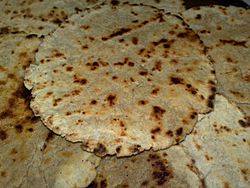Bhakri facts for kids

Bhakri
|
|
| Type | Chapati |
|---|---|
| Place of origin | India |
| Region or state | Maharashtra, Gujarat, Rajasthan, Malwa, Central India, Karnataka, and Goa |
| Main ingredients | Flour |
Bhakri is a type of round, flat bread, much like a roti or chapati. It's a popular food in several parts of India, especially in the states of Gujarat, Maharashtra, Rajasthan, and Karnataka.
Bhakri is often made from different kinds of flour, like jowar (sorghum) or bajra (pearl millet). These flours make the bhakri a bit rougher than a regular wheat chapati. Bhakri can be either soft or hard, depending on how it's made and what it's served with.
What Grains Are Used?
Bhakri is usually made from different types of millets. Millets are small-seeded grasses grown as grain crops. The most common millets used are jowar, bajra, and ragi (finger millet). These millet bhakris are very popular in the Deccan Plateau regions of India, like Maharashtra and Northern Karnataka. They are also eaten a lot in the dry areas of Rajasthan.
In the coastal areas of Konkan and Goa in western India, people often use rice flour to make their bhakri.
Here are some common types of bhakri:
- Jowar Bhakri: This is the most common type. The dough is made by mixing jowar flour with hot water. Then, it's flattened by hand into a round shape.
- Bajra Bhakri: People mainly make bajra bhakris in winter, especially around the Sankranti festival. It's made in a similar way to jowar bhakris.
- Makai Bhakri: This bhakri is made from cornmeal and is also popular in winter. It's known as "Makai No Rotlo" in Gujarati and "Makyachi Bhakri" in Marathi.
- Ragi Bhakri: Also called ragi rotti, these are made from red finger millet. They are prepared just like other bhakris.
- Rice Bhakri: Made from rice flour, these bhakris are common in the Konkan region.
- Wheat Bhakri: These are similar to wheat rotis but are usually bigger and thicker.
- Pulse Bhakri: This bhakri is made from urad dal (black gram) or a mix of urad and jowar flour. It's also known as Kalna bhakri and is very popular in the Khandesh region.
To make bhakri, flour is mixed with a little salt and hot water to create a smooth, firm dough. Small balls are made from the dough. These balls are then flattened using the palms of the hands. Some people are very skilled and can make the bhakri thin by holding the dough ball in both palms.
Once flattened, the bhakri is cooked on a hot tava (a flat pan). A little water is spread on the top surface with fingers. After one side is cooked, the bhakri is flipped. Finally, it's roasted directly over a flame on both sides until it puffs up slightly and is cooked through.
How Bhakri is Served
Bhakri is usually served with many different side dishes. Some common pairings include yogurt, spicy garlic chutney, Pithla (a thick chickpea flour curry), baingan bharta (a dish made from roasted eggplant), thecha (a spicy chutney made from green chilies and peanuts), green leafy vegetables, and raw onion.
In northern parts of Karnataka, bhakri is often eaten with stuffed brinjal (eggplant) curry. In the Vidarbha region, it's served with "Zunka," which is a thicker version of Pithla.
Historically, bhakri was a main food for people living in rural areas. They would often take it to the farm early in the morning, and it would serve as both breakfast and lunch. Sometimes, bhakri even acted as a plate! People would put chutney or thecha directly on the bhakri and eat it all together.
In the Khandesh region, bhakri and shev bhaji (a thick curry made from sev, a crispy snack) is a very popular meal. In coastal areas like Konkan and Goa, rice flour bhakris are mainly served with fish curry.
Today, wheat rotis and phulkas (another type of flatbread) are more common. However, bhakri still remains popular in many regions and is enjoyed as a special dish.
See also
 In Spanish: Bhakri para niños
In Spanish: Bhakri para niños 

